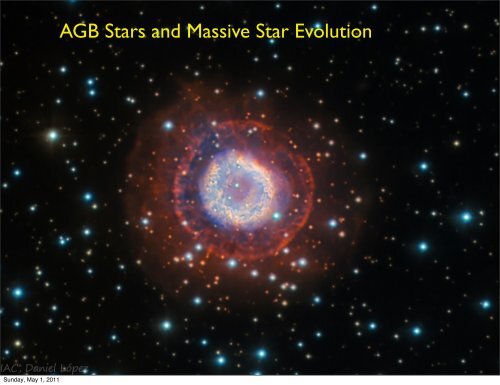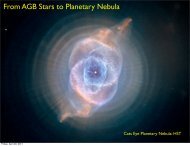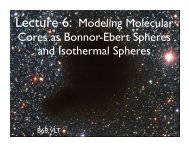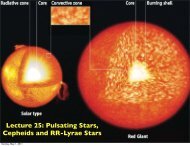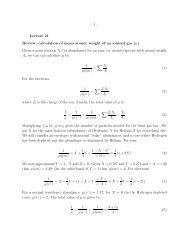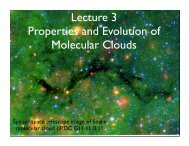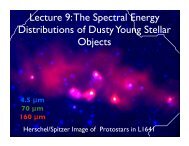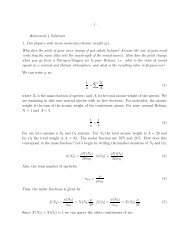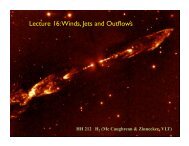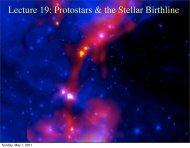Lecture 24: AGB Stars and Massive Star Evolution
Lecture 24: AGB Stars and Massive Star Evolution
Lecture 24: AGB Stars and Massive Star Evolution
You also want an ePaper? Increase the reach of your titles
YUMPU automatically turns print PDFs into web optimized ePapers that Google loves.
Sunday, May 1, 2011<br />
<strong>AGB</strong> <strong><strong>Star</strong>s</strong> <strong>and</strong> <strong>Massive</strong> <strong>Star</strong> <strong>Evolution</strong>
Sunday, May 1, 2011<br />
Iben
The Helium Flash (< 2 Msun)<br />
The central core becomes dense enough, that degeneracy pressure<br />
dominates over thermal pressure. Still, the core radiates energy <strong>and</strong><br />
continues to contract, until Helium fusion occurs.<br />
Helium burning<br />
Once He fusion stars, temperature goes up, but core doesn’t exp<strong>and</strong><br />
immediately. This creates a brief burst of energy, much of which goes<br />
into inflating the core <strong>and</strong> star..<br />
Sunday, May 1, 2011
Degeneracy occurs<br />
when there are not<br />
enough quantum states<br />
at low velocities, pushing<br />
electrons to higher<br />
momentum (i.e. velocity)<br />
states.<br />
From Bohm Vitense<br />
Sunday, May 1, 2011
Nuclear Burning: the triple α process<br />
4 He + 4 He -> 8 Be<br />
8 Be+ 4 He -> 12 C<br />
q = k ρ 2 T 40<br />
Releasing 7.275 Mev (compared 25 Mev<br />
for Hydrogen burning)<br />
When enough carbon accumulates:<br />
12 CO + 4 He -> 16 O<br />
Releasing 7.162 Mev<br />
Sunday, May 1, 2011
The Horizontal Branch<br />
The core exp<strong>and</strong>s <strong>and</strong> nuclear reaction rates <strong>and</strong> luminosity may<br />
decrease. The star then enters a helium burning main sequence.<br />
Helium burning<br />
Hydrogen burning<br />
At this point the star is relatively steady for 10 8 years. However,<br />
pulsations may occur. Luminosities of 50-100 Lsun.<br />
Sunday, May 1, 2011
Eddington<br />
Luminosity<br />
http://www.atlasoftheuniverse.com/hr.html<br />
http://stars.astro.illinois.edu/sow/hrd.html<br />
Sunday, May 1, 2011
Piotto et al.<br />
RR Lyrae gap<br />
2002<br />
Less Envelope<br />
More Envelope<br />
Sunday, May 1, 2011
Asymptotic Giant Branch<br />
Now the central carbon/oxgen core becomes unstable <strong>and</strong> starts<br />
to contract. There is now Helium <strong>and</strong> Hydrogen burning in shells.<br />
Helium burning<br />
Hydrogen burning<br />
The star may become a supergiant. However, pulsations <strong>and</strong> dust<br />
formation in the envelope may lead to the ejection of the envelope,<br />
leaving a white dwarf.<br />
Sunday, May 1, 2011
MS<br />
Sub-giant<br />
to Giant<br />
Horizontal<br />
Branch<br />
<strong>AGB</strong><br />
Prialnik<br />
Sunday, May 1, 2011
Thin Shell Instabilities<br />
In Hydrostatic Equilibrium<br />
Prialnik<br />
Sunday, May 1, 2011
Imagine layers exp<strong>and</strong>s. If pressure from surrounding gas (i.e.<br />
hydrostatic equilibrium) drops faster than the pressure in<br />
expansion, layer continues to exp<strong>and</strong> <strong>and</strong> cool. If not,<br />
temperature rises <strong>and</strong> we get thermal instability.<br />
Prialnik<br />
Sunday, May 1, 2011
H -> He<br />
in convective<br />
region<br />
Dredge Up<br />
Prialnik<br />
Sunday, May 1, 2011
<strong>AGB</strong> stars pulsing<br />
Schwarzchild &<br />
Harm (1967)<br />
Sunday, May 1, 2011
The 9th Cycle<br />
Schwarzchild & Harm (1967)<br />
Sunday, May 1, 2011
Carbon Burning<br />
12 C + 12 C -> <strong>24</strong> Mg + γ<br />
12 C + 12 C -> 23 Mg + n<br />
12 C + 12 C -> 23 Na + p<br />
~13 ΜeV per reaction<br />
12 C + 12 C -> 20 Ne + α<br />
12 C + 12 C -> 16 Ο + 4α<br />
Sunday, May 1, 2011
When does degeneracy happen?<br />
Prialnik<br />
Sunday, May 1, 2011
Carbon<br />
Burning in<br />
Intermediate<br />
Mass <strong>AGB</strong><br />
<strong><strong>Star</strong>s</strong><br />
Siess et al. 2006<br />
Sunday, May 1, 2011
Carbon<br />
Burning in<br />
Intermediate<br />
Mass <strong>AGB</strong><br />
<strong><strong>Star</strong>s</strong><br />
Siess et al. 2006<br />
Sunday, May 1, 2011
Sunday, May 1, 2011<br />
Prumo & Siess 2007
Sunday, May 1, 2011
Sunday, May 1, 2011
The Supergiant Branch<br />
Relatively Constant Luminosity<br />
http://www.atlasoftheuniverse.com/hr.html<br />
http://stars.astro.illinois.edu/sow/hrd.html<br />
Sunday, May 1, 2011
Sunday, May 1, 2011<br />
Prialnik
The Blue Loop Excursions<br />
Contracting core <strong>and</strong> Hydrogen shell burning lead to large envelope <strong>and</strong> red colors.<br />
Helium burning in core implies exp<strong>and</strong>ed core <strong>and</strong> shell, smaller envelope <strong>and</strong> bluer colors.<br />
Sunday, May 1, 2011
The Blue Loop Excursions<br />
Sunday, May 1, 2011
<strong>Massive</strong> <strong>Star</strong> <strong>Evolution</strong><br />
Maeder et al. 1990 A&AS 84, 139<br />
Sunday, May 1, 2011
Sunday, May 1, 2011
Sunday, May 1, 2011
Semi-Convection<br />
Opacity per mass higher for Hydrogen then Helium<br />
(more electrons per mass)<br />
Imagine core of 40% Helium surrounded by an<br />
envelope layer of mostly 10% Helium. High<br />
opacity leads to convection, which mixes Helium<br />
into envelope, lowering opacity.<br />
Thus, such regions may have slow convection just<br />
to keep material mixed.<br />
Sunday, May 1, 2011
Sunday, May 1, 2011
Summary<br />
Asymptotic Giant Branch phase occurs after Helium core burning.<br />
Thin shell instability in helium burning leads to pulsations.<br />
These pulsations lead to significant change in luminosity. Helium <strong>and</strong><br />
Hydrogen shell burning alternate.<br />
Intermediate mass <strong>AGB</strong> stars may have carbon burning phase.<br />
<strong>Massive</strong> stars shown mainly evolution in temperature (close to<br />
Eddington limit). Mass loss important.<br />
Contains nested shells of nuclear burning, up to Iron<br />
Semi-convection mixes hydrogen <strong>and</strong> helium in core,<br />
Sunday, May 1, 2011


